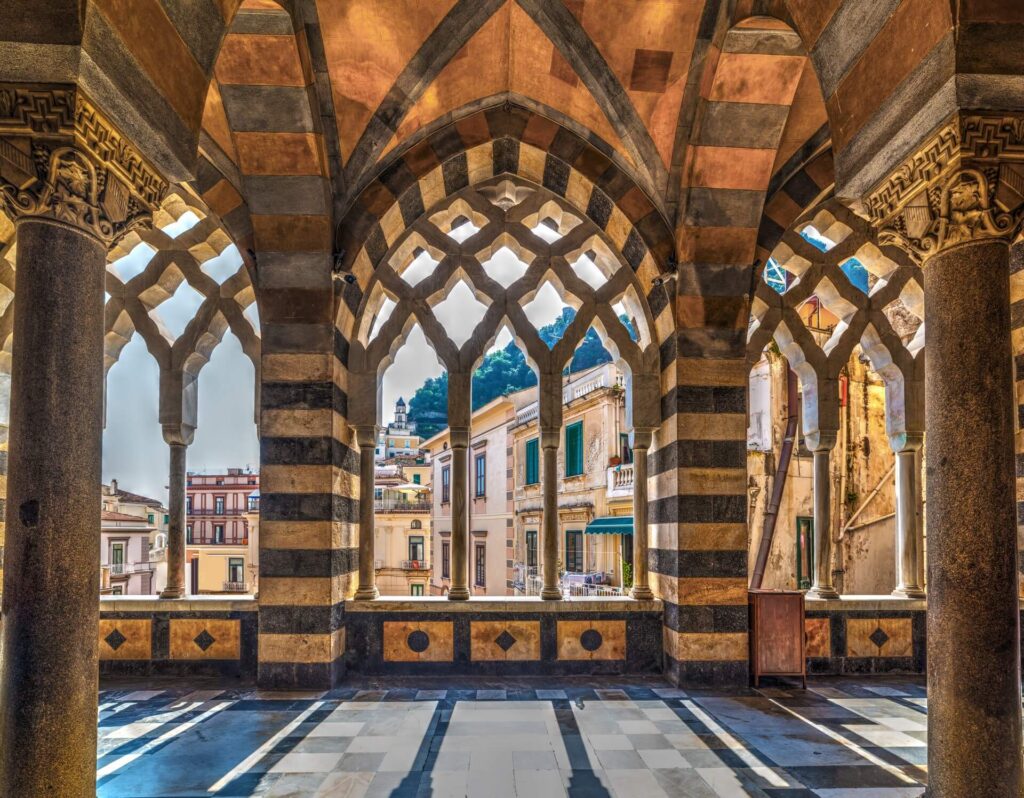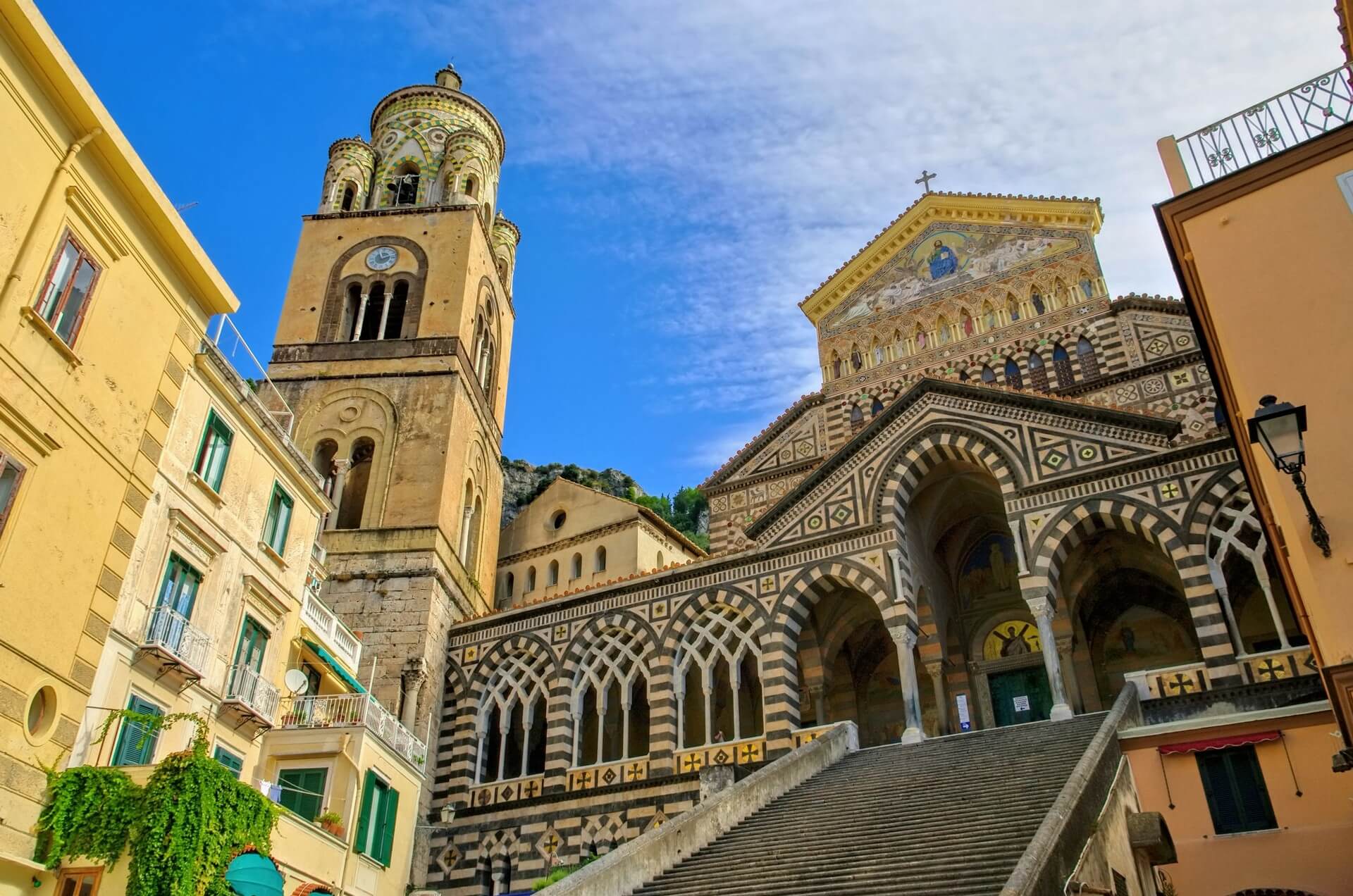The Amalfi Coast, also known as the Amalfi Coast, is the approximately 50-kilometer-long stretch of coastline located between the Gulf of Naples and the Gulf of Salerno.
Famous for its picturesque towns perched on cliffs, crystal-clear waters and breathtaking views, it became aUNESCO-protected World Heritage Site in 1997, and is world-renowned for its beauty and perfect blend of landscape and history.
Its rugged coastline, alternating with small coves and enchanting beaches, is dotted with seaside villages that retain the charm of a bygone era. The history of the Amalfi Coast is rich and fascinating. It dates back to medieval times, when the Republic of Amalfi was a leading maritime power and the other towns were just hamlets of simple people. Read on and learn more about this little piece of paradise!
What to see on the Amalfi Coast
The Amalfi Coast is recognizable by the profile of the coastline on which the villages lie, surrounded by terraces for the cultivation of vines and citrus fruits. Today it is a favorite destination for visitors from all over the world, who are also attracted by the exclusive atmosphere that has been around for decades.
In fact, in order to move with more agility, we recommend that you book aprivate excursion to better enjoy the trip. Getting there is not that complicated, but benefiting from moderately priced parking is almost impossible. But now let's get going!
Vietri sul Mare
The ideal first stop on your Amalfi Coast trip begins in Vietri sul Mare, which is actually the last town before Salerno. It is the least chased by tourists and yet it offers splendid views of the coast. Like the ones you can admire while walking through its Villa Comunale, overlooking the sea. Already from here you understand what Vietri's vocation is: ceramics. Don't say goodbye without taking a souvenir made by a Vietri artisan with you!
Maiori, Minori and Cetara
Continuing along the coast, one comes to Maiori and Minori, two seaside towns that boast golden sandy beaches and crystal-clear waters. Maiori developed especially after receiving the attentions of Roberto Rossellini, who chose it as a location for several films. Undoubtedly worth visiting is the abbey of Santa Maria de Olearia. But an unmissable experience is to walk the Lemon Trail, which connects it to Minori.
It seems that Maiori is the town among the smallest in Italy, but Cetara is not to be outdone. We can consider it a small treasure, which has all the qualities of coastal places, but it is lived with greater tranquility. Pastel-colored houses, clear waters, the scent of the sea: a walk in Cetara is rejuvenating.
Amalfi
Amalfi is the true pearl of the Amalfi Coast. Its glorious past as a Maritime Republic has ensured that nature and culture go perfectly together here. The Cathedral of St. Andrew the Apostle, with its Paradise Cloister, is a masterpiece of Arab-Norman architecture and certainly its biggest attraction.

But we suggest at least 3 places for you to visit:
- l'Arsenal of the Republic, with an adjoining Museum of the Compass and the Marine Duchy;
- the Paper Museum, to find out how Amalfi's prized handmade paper is made;
- the Valley of the Mills, if you fancy an easy trek among waterfalls and pools of water.
Positano
Positano, perched on a cliff overlooking the sea, is one of the most iconic villages on the Amalfi Coast. Its colorful houses and narrow streets have made it one of the most sought-after tourist destinations in the world. In fact, it is to date the most "chic."
Yet once there were only fishermen here, until it first attracted the interest of artists and artisans. Today Positano's best-known products are handcrafted sandals and linen and lace garments. An archaeological site worth visiting has been open for a few years and is the Positano Roman Villa. The villa is located below the church of Santa Maria Assunta, near the beach.
Ravello
Two historic sites not to be missed are found in Ravello, situated on a promontory overlooking the coast. The town is now also famous thanks to the music festival in honor of Richard Wagner, the Ravello Festival to be exact. Every year, the event is held at Villa Rufolo, an enchanting venue for both its sea views and its flower-filled park. But the panorama ofVilla Cimbrone, from the Terrace of Infinity, really leaves one speechless. And so this stop is also one to put on your bucket list.
What to see around the Amalfi Coast: Sorrento and Vico Equense
Coming from Naples, before the Amalfi Coast begins, we encounter two very well-known resorts. One is Vico Equense and the other is Sorrento.
Vico Equense is a diffuse municipality, that is, it consists of several hamlets: the most famous on the sea is Seiano, and the others are located on the higher part of the coast. Not to be missed is the belvedere at the church of Santissima Annunziata, from which one can admire the high cliffs of the Sorrento coast and Vesuvius. Vico is also less crowded than nearby Sorrento, perhaps more enjoyable.
However, it is impossible not to drop by Sorrento as well. In order not to miss any of the city's most representative places, we recommend a guided tour. In Sorrento, the must-see stops are:
- The Cathedral of Saints Philip and James;
- the poetic cloister of St. Francis;
- the Municipal Villa;
- the Salvatore Baths, for a dip in the center of town, on the equipped beach, swimming among the remains of the Roman city;
- Queen Joan's Baths, for total immersion in nature.
What to eat on the Amalfi Coast
No self-respecting trip is complete without savoring the typical dishes of the local culinary tradition. And the Amalfi Coast offers some real delicacies. Here is a roundup of dishes to try:
- ndunderi of Minori, a special kind of tomato dumpling;
- Eggplant with chocolate, fried and typical of Maiori;
- the Santa Rosa sfogliatella, the ancestor of the Neapolitan riccia, with custard and sour cherries;
- the pasta with colatura di alici di Cetara;
- tuna genovese, a first course and variation of the well-known Neapolitan genovese, originally from Cetara;
- lemon delight, a spoon dessert with lemon cream;
- the pizza a metro from Vico Equense, different from the classic Neapolitan preparation, but equally delicious.
And finally, let's not forget the limoncello!


